Can You “Future Proof” Your Design Strategies?

Originally published on LinkedIn by Sean Svendsen on November 12, 2018
The Future….Now?
A failure of imagination is the undoing of many great design strategies.
At Priority Designs we are often asked to participate in or lead design strategy creation. Business leaders naturally want to reduce risk and base their design strategies on data that is verifiable and quantifiable. To support this, we conduct voice-of-customer research to understand customer wants and needs. We analyze competitive landscapes to find opportunities for differentiation and lead investigations with stakeholders to identify internal strengths and weaknesses. These are all rational and necessary inputs to build a strategy on.
However what would it look like to go beyond what’s happening now and recently? How do we consider what may happen in the future, even prepare for it?
It’s easy to see why many may not want to account for the future in strategic thinking. After all, the future is not known, and can’t be accurately predicted. But today change happens at an increasing rate and we need to have the courage to do this if we want to “future proof” our design strategies.
For this to happen, strategists need to be thinking farther into the future and Strategic Foresight is a tool that allows us to “look backward from the future.” More specifically, Strategic Foresight is the practice of peering into the future, imagining potential outcomes and then backcasting from the future to build strategies that are more flexible, adaptive and robust. It’s not about predicting the future, rather it’s about planning for any future.
We’ll go through why it’s important to look to the future now, learnings about Strategic Foresight from The Futures School, and how to use Strategic Foresight to impact your strategies for today.
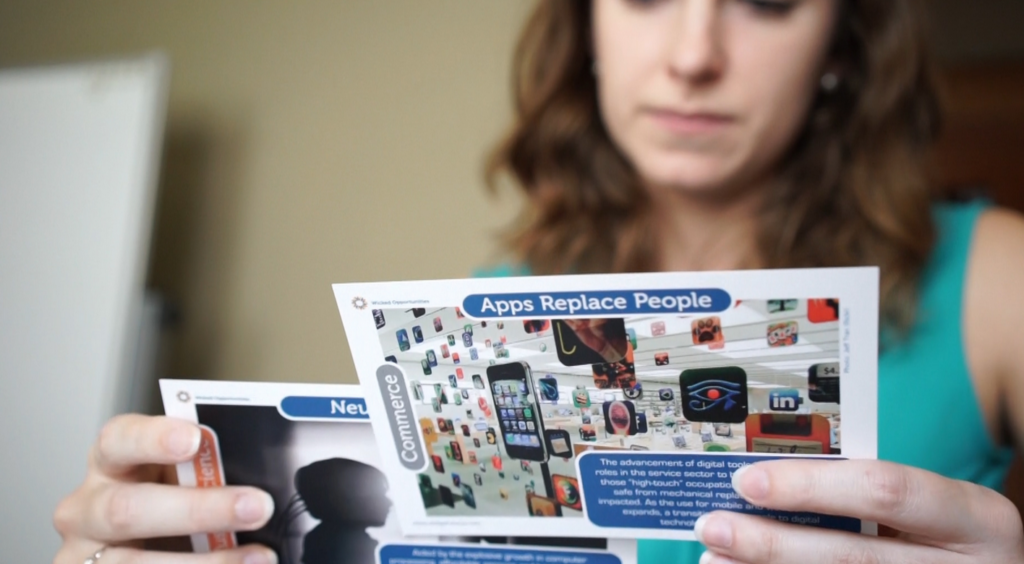
Don’t Blink. You’ll Miss the Future.
Don’t Blink. You’ll Miss the Future.
The rate of change in our world is speeding up. The future is coming at us fast.
Prior to the industrial age, fundamental change in society happened by the century (if at all). We saw the pace accelerate during the industrial age through the development of new communication and transportation technologies. After that, we experienced change by the decade in the second part of the last century. Now, in the information age, the rate of change is gaining momentum and we are experiencing change more frequently than any generation prior.
We are currently living in an age of rapid and widespread access to much of the world’s known information. This access to knowledge allows humanity to combine information and push development of new technologies like virtual reality, robotics, automation and genetic coding. While the smartphone seemed like an amazing and hugely transformative piece of tech just ten years ago, the world is about to be hit by a tsunami wave of inventions such as Internet-Of-Things (IOT) devices, autonomous vehicles, drones, and wearables enabled with sensing, awareness, adaptive intelligence, and hyper connectedness.
This new tech will allow us to collaborate and utilize information in ways that may force us to re-think what is normal and accepted. They may collapse old ways of working, learning, communicating and socializing. They may force us to re-evaluate our economies, governments, borders, and social structures. The rate of change is beginning to spiral so quickly, that our strategies must be looking farther ahead into the future to allow us time to be proactive rather than reactive.
Therefore, a perspective from the fuzzy future should be developed and blended with hard data from current insights to understand where we are, and where we might go. But, how can this be done when the future is so blurry? This is where Strategic Foresight comes in.
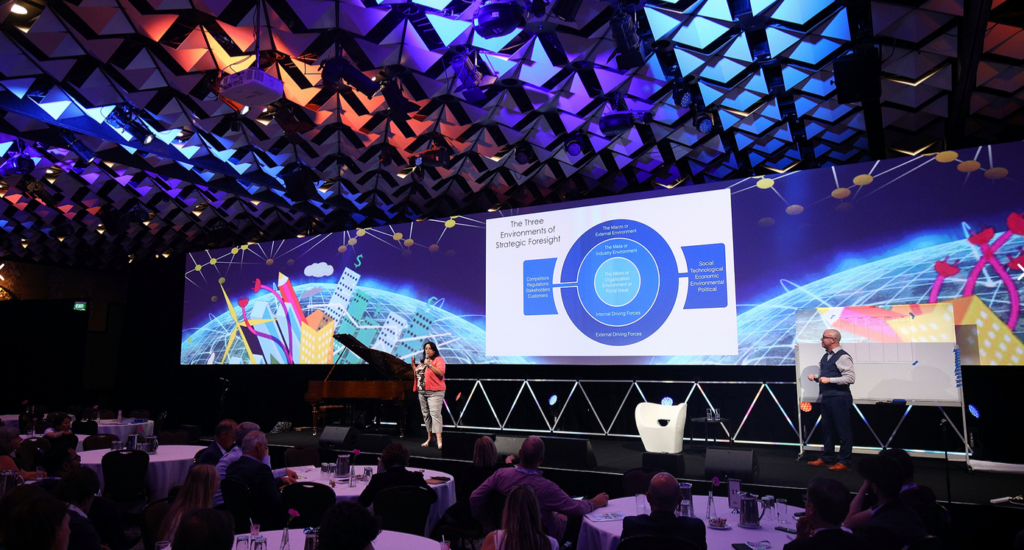
Strategic Foresight
Strategic Foresight
I first heard of the concept of Strategic Foresight in a keynote address given by Frank Spencer at the 2018 Mid-East District IDSA Conference. In Frank’s talk, he spoke of the dangers of not incorporating future thinking into your strategies and the benefits of looking backward from the future to make your strategies more adaptive. Frank is a futurist and his company Kedge has consulted for diverse companies such as Disney, Lego, NASA, Target, Ford, Charles Schwab, and P&G. These companies have applied strategic foresight to a wide range of business topics including high level organizational planning, HR development, financial systems, marketing, branding and product development. Frank is also the Lead Instructor at The Futures School which helps educate professionals and students how to develop future thinking.
The basic process of strategic foresight is:
- Scanning to identify trends.
- Analyzing trends to identify patterns.
- Using the patterns to create multiple future scenarios.
- Using the scenarios to test your strategies against and see what changes or additions are needed to be make them adaptive.
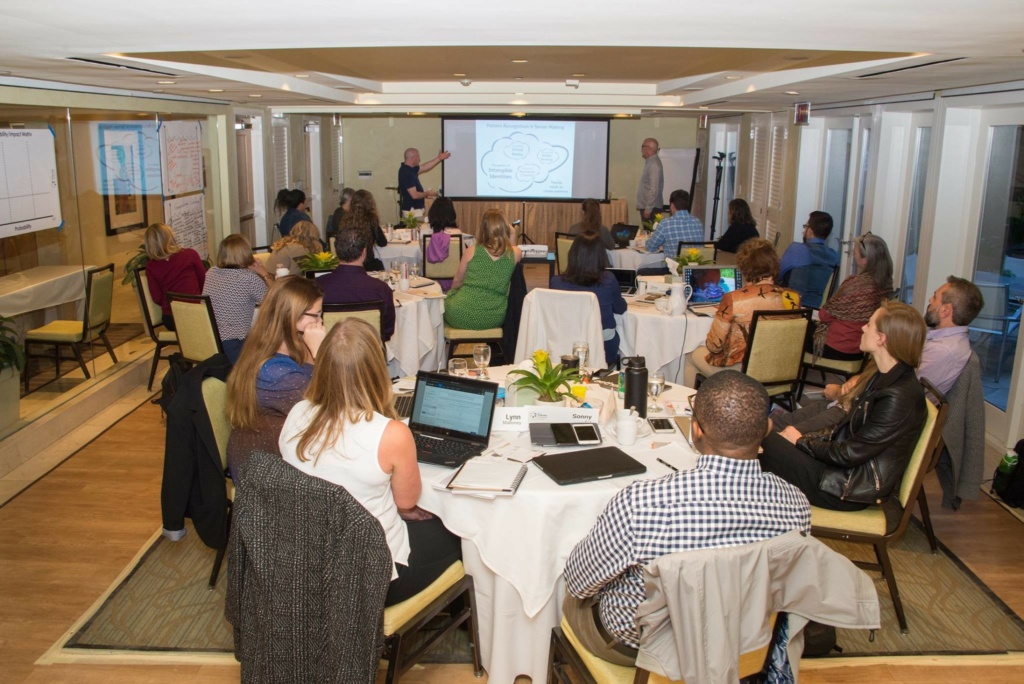
I recently attended The Futures School’s 3-day seminar which is a course that teaches the process and methods of strategic foresight and equips participants with tools for incorporating future thinking. Frank Spencer presented the material along with fellow instructor Richard Rasmey, former vice-president at The Walt Disney Company. The seminar is not just teaching, but also a workshop that gives opportunities to put learning into practice.
About 30 other participants attended the seminar from a diverse group of companies representing healthcare, insurance, business services, product development consulting, fashion, entertainment industries, education and government sectors. The group included designers, researchers, strategists, vice-presidents and other organizational leaders. Although our backgrounds were very different, one thing we all had in common was that we all regularly participate in some form of strategic planning.
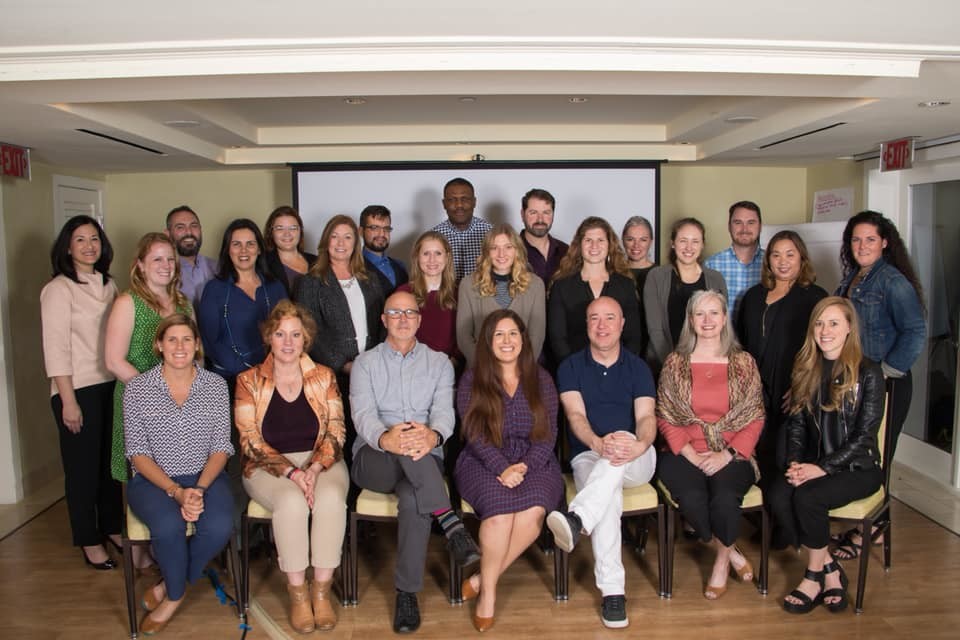
Prior to arrival, we were all interviewed to determine our personalities, interests, backgrounds and skill sets. The large group was broken into six smaller teams of 5-6 people who were pre-arranged to create diversity within our teams. These smaller teams worked together to analyze information and apply the thinking across each of the three days.
Day one of the seminar involved an overview of the Strategic Foresight process and a discussion about the bias individuals often have and how our internal “mental filters” can impact our ability to analyze trends. Hence the need for diversity within our teams. We also studied clips from sci-fi movies to demonstrate the power of “shifting our minds from the plausible to the provocative.”
Day two of the seminar involved learning about Causal Layered Analysis which can help identify problems and provide a deeper understanding of their root cause. This tool can also be used in reverse to understand at what level these problems need to be addressed if fundamental change is desired.
Next, we learned about scanning and pattern building. The Futures School prescribes scanning for a wide range of change drivers including social, technological, economic, environmental and political trends, (or S.T.E.E.P. for short). Using this framework, each team used various trends to develop patterns and opinions around where these trends might be headed.
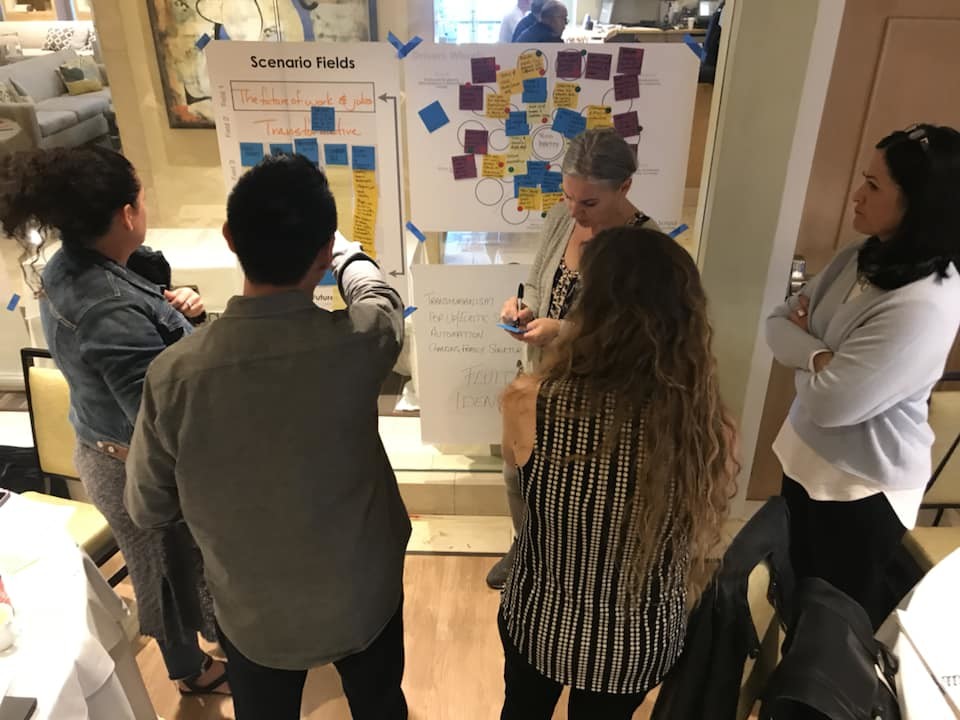
Practicing Future-Thinking
Practicing Future-Thinking
All teams were asked to look 20 years forward and envision the “future of workers and jobs” as a focal issue for the seminar. Our team looked at the trends of digital activism, hyper local, hybrid value chains, wearable tech and collaborative consumption. Together, we started to envision these into a pattern of “Hyper Connectivity” and the impact it might have on future workers.
Throughout the seminar, we learned about using our patterns to develop multiple future scenarios. We were asked to envision the future like a cone. What’s happening right now is at the small pointed end. In the short term and looking forward, the cone is narrow because the near future is less uncertain, but as we go outward in time the cone becomes wider and more uncertain. Building multiple future scenarios helps us account for a range of possible outcomes.
On day three of the seminar we learned about tools for developing, testing and refining strategies based on our scenarios. We also dove deeper into scenario building. Each team created more fully developed future worlds for our patterns with characters, systems, and artifacts involving our scenarios. Each team was asked to create a story that represented our future world scenario.
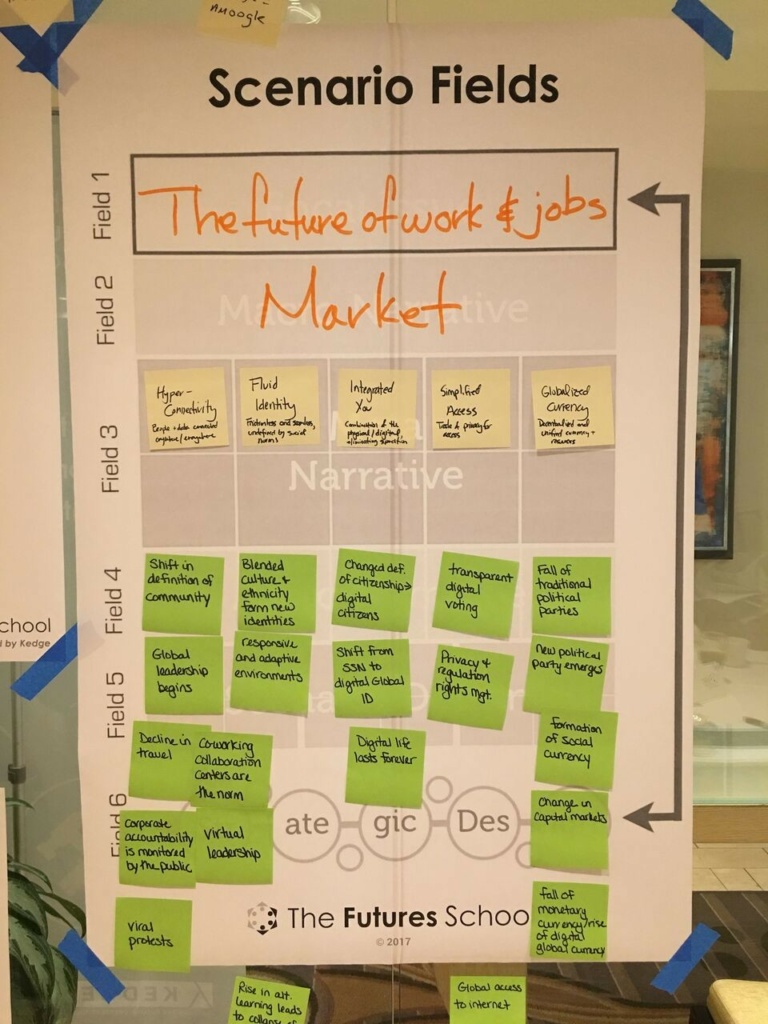
Our team told the story of a future “Gig Based Economy.” Here’s the scenario:
- Massive business consolidation has occurred. Most future companies act as scalable entities with very few permanent employees.
- Companies use Blockchain and artificial intelligence to create and manage assignments and it crowd sources tasks or “gigs” to be done.
- The heroine in our story comes back from surfing on a Wednesday. Using an anonymous avatar profile, she logs in telepathically through her wearable device to find her next gig. Rather than working a typical 9-5 day as an employee for a single employer, she acts autonomously and performs gigs for thousands of potential employers.
- She decides if, when, and who she wants to work for. She selects gigs from a database supported by Blockchain for whatever she is qualified for. Artificial Intelligence reviews workers based on their avatar profile. If qualified, she gets the gig. No interview is necessary.
- After the gig is performed her skills are rated based on her performance and she is paid accordingly in Crypto-Credits.
- Layers of management have been greatly reduced allowing the companies to run more efficiently and workers have more freedom.
Basically, our future scenario is like Uber and Amazon Mturk taken to the next extreme. Is this a probable future? It doesn’t matter. It’s possible, and the point is to be provocative and inspire thought. If we were planning a long-term strategy about HR planning it should cause discussion about how to make our plan responsive and adaptive should we start to see early signs that a possible future, or even parts of it, are coming to fruition.
The Futures School 3-day seminar crams about a college semesters’ worth of theory, applications and practice into just a few short days, but I found the class to be very rewarding. It caused me to start adjusting my vision farther into the future and equipped me with several new tools to start applying immediately.
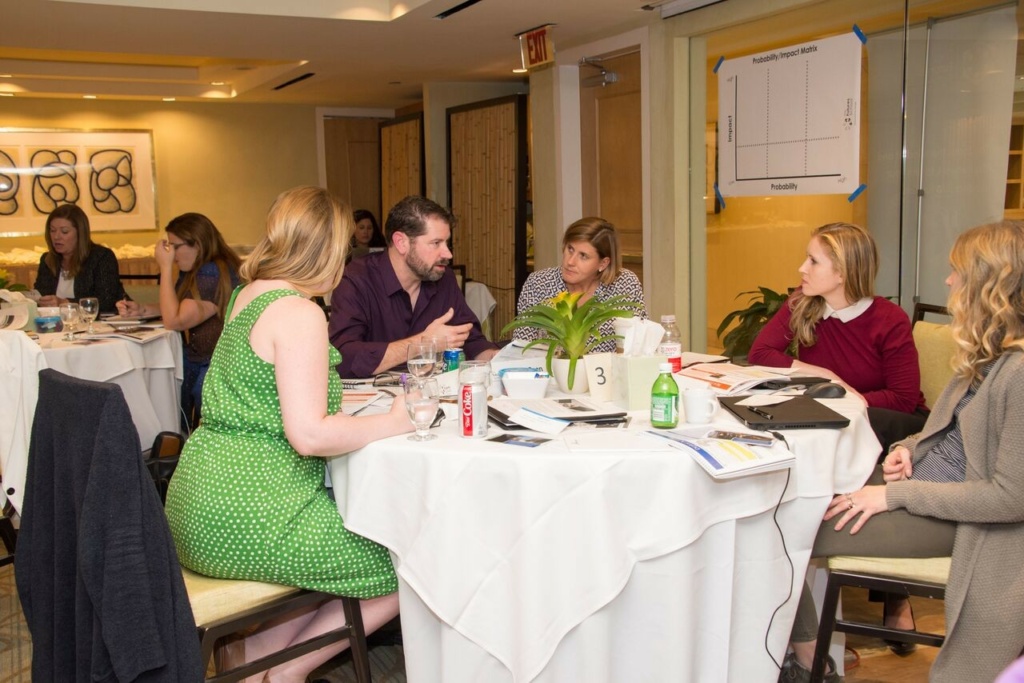
Start Imagining
Start Imagining
It’s important to consider Strategic Foresight because the world is changing at a pace like never before. So, it’s time to think ahead.
With Strategic Foresight, you scan to identify trends, analyze and identify patterns, create multiple future scenarios, and test strategies against these scenarios and adjust to make them adaptable.
The Futures School helped provide a valuable toolbox for teams to build out successful strategies for the future. Remember these guidelines as you work:
- Create diverse teams.
- Get inspired! Shift your mind from the plausible to the provocative.
- Look to a wide range of change drivers.
- Think of the future like a cone. The further out in time, the range of outcomes grows.
- Apply characters, systems, and artifacts to make fully-flushed out scenarios.
- Test your current design strategies against a wide range of possible future scenarios.

Sean Svendsen
Sr. Design Research and Strategy Lead, Stratos Innovation Group
Global Foresight Advisory Council Member
Sean Svendsen’s forte is helping clients create unique, relevant and authentic brand stories. Then he helps them communicate the stories consistently through visual brand language and compelling user experiences. He has a wide range of experience developing products, packaging, displays, environments and events for clients such as Nike, Stanley Black & Decker, American Standard, TaylorMade Golf and Cardinal Health.
Learn More
